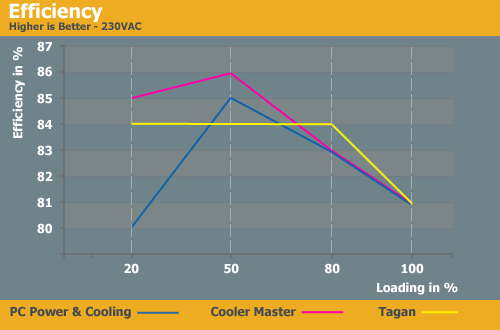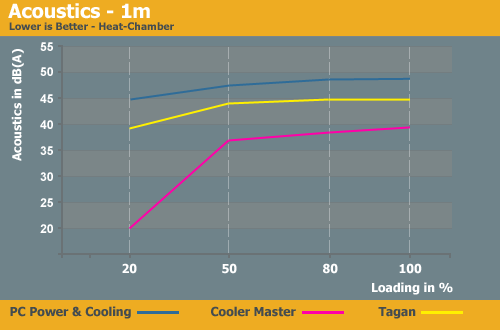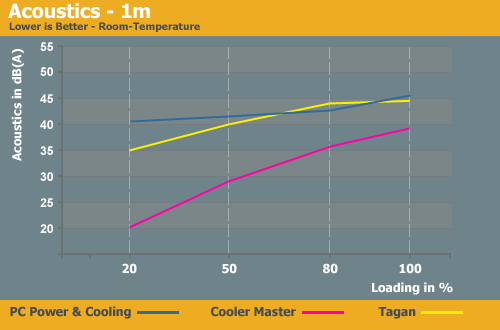Ultra High-End PSU Roundup
by Christoph Katzer on October 22, 2007 6:00 AM EST- Posted in
- Cases/Cooling/PSUs
Comparison and Conclusion
We have seen three totally different approaches to strong power supplies from the technology side today. PC Power & Cooling is using one fan and has in fact two separate power supplies in one chassis. We have already written about the disadvantages about this topology and when we compare the efficiency and noise later we will not see real advantages. Cooler Master is buying a very good basic design, and many other companies are using this design as well. There is little that can go wrong when buying from Enhance and the results show that. Finally, we have Tagan whose layout is a very good enhancement of the first revision and it shows almost no flaws in the performance.

From the appearance all power supplies make a very good stand and from the cable point of view they are all similar. The lengths are decent and the choice of connectors is also good. The Turbo Cool at 1200W is the lowest wattage unit on the field today, and it also has the fewest number of SATA and Molex connectors. We think that with 1200W you might want to have more connectors to choose from and not only six SATA and eight Molex - a few more would have been appreciated. Cooler Master is not looking too much better and has just two SATA connectors more and even one Molex less, but they do offer more PEG connectors. Tagan is top of the class you in this area with 12 SATA connectors, all of a decent length. All three power supplies have a decent amount of graphics card connectors and with these and it's hard to imagine anybody will have a problem.

The efficiency levels are good with all the models we have seen today. Cooler Master has slightly better results with lower and medium loads than the other two and Tagan keeps up its efficiency from 84% with 230VAC over the complete time of loading between 20 and 80%. With 86% Cooler Master leads the pack until beyond the half-way point in the "race", but overall the power supplies all performed well and there is nothing to complain about.


As we have mentioned before if you really want to have a 1000W+ power supply you cannot expect it to be quiet - especially not at full load. 1000W produced in the power supply leaves a lot of heat and this heat needs to be exhausted (unless you're planning on frying eggs inside your computer). This can only be done with a very good design layout and a decent fan. PC Power & Cooling clearly isn't the most elegant approach, instead opting for brute force in order to provide adequate airflow. The fan needs to be strong to reach around all the small corners where hot air could hide, and this creates a lot of noise. Cooler Master has a better approach with a 12cm fan that is just pushing enough air into the power supply to cool all of the components. The fins of the heat sinks are thick but with enough space between them that air can reach even to the PCB. In terms of intelligent cooling we have to admit that Tagan also has a very nice design which serves its purposes. Unfortunately, here we again have a very noisy fan which will probably wake the neighbors.
The DC outputs were good except for the Tagan ITZ which showed a view flaws. The voltage regulation functions very well, and even at the highest loads and with 10% overloading the three units stand their ground. In case of ripple and noise, we saw flaws with the Tagan ITZ where we measured fluctuations of up to 130mV on the 12V rail and quite high ripple at the 3.3V rail as well. PC Power & Cooling has not more than 12mV to show which is a very good result.
Pricing is a bit odd than the air, as two of the power supplies are not out yet. The Tagan ITZ with 1300W is already available for $399 USD and will not be available in the European market. Maxpoint told us they are working on European products which will have a different name when they are finally released. PCP&C will launch the Turbo Cool with 1200W for $499 USD and the release will be shortly. Cooler Master will launch their Real Power Pro for around $370 USD in the market. The European prices for these two products are not yet decided but the rough exchange rates for both of the models are 260 EUR for the Real Power Pro and the PCP&C Turbo Cool will be around 350 EUR at actual exchange rates. These prices make both the Tagan and Cooler Master a bargain since the prices will still surely fall during the first week of release.
Having seen these three power supplies now we can't really come up with a real suggestion which one to buy. All of them managed to deliver the rated power and even a little bit more. In the end the user has to decide which one will best fit their needs, although perhaps the more pertinent question to ask here is if there is really a need for huge power supplies like this at all? Just as not everyone needs quad-core processors, multiple graphics cards, extreme overclocking, and/or a dozen hard drives running in multiple RAID arrays, there are plenty of computer users that will likely never need anything near 1000W of power for their home computer.
We have seen three totally different approaches to strong power supplies from the technology side today. PC Power & Cooling is using one fan and has in fact two separate power supplies in one chassis. We have already written about the disadvantages about this topology and when we compare the efficiency and noise later we will not see real advantages. Cooler Master is buying a very good basic design, and many other companies are using this design as well. There is little that can go wrong when buying from Enhance and the results show that. Finally, we have Tagan whose layout is a very good enhancement of the first revision and it shows almost no flaws in the performance.

From the appearance all power supplies make a very good stand and from the cable point of view they are all similar. The lengths are decent and the choice of connectors is also good. The Turbo Cool at 1200W is the lowest wattage unit on the field today, and it also has the fewest number of SATA and Molex connectors. We think that with 1200W you might want to have more connectors to choose from and not only six SATA and eight Molex - a few more would have been appreciated. Cooler Master is not looking too much better and has just two SATA connectors more and even one Molex less, but they do offer more PEG connectors. Tagan is top of the class you in this area with 12 SATA connectors, all of a decent length. All three power supplies have a decent amount of graphics card connectors and with these and it's hard to imagine anybody will have a problem.

The efficiency levels are good with all the models we have seen today. Cooler Master has slightly better results with lower and medium loads than the other two and Tagan keeps up its efficiency from 84% with 230VAC over the complete time of loading between 20 and 80%. With 86% Cooler Master leads the pack until beyond the half-way point in the "race", but overall the power supplies all performed well and there is nothing to complain about.


As we have mentioned before if you really want to have a 1000W+ power supply you cannot expect it to be quiet - especially not at full load. 1000W produced in the power supply leaves a lot of heat and this heat needs to be exhausted (unless you're planning on frying eggs inside your computer). This can only be done with a very good design layout and a decent fan. PC Power & Cooling clearly isn't the most elegant approach, instead opting for brute force in order to provide adequate airflow. The fan needs to be strong to reach around all the small corners where hot air could hide, and this creates a lot of noise. Cooler Master has a better approach with a 12cm fan that is just pushing enough air into the power supply to cool all of the components. The fins of the heat sinks are thick but with enough space between them that air can reach even to the PCB. In terms of intelligent cooling we have to admit that Tagan also has a very nice design which serves its purposes. Unfortunately, here we again have a very noisy fan which will probably wake the neighbors.
The DC outputs were good except for the Tagan ITZ which showed a view flaws. The voltage regulation functions very well, and even at the highest loads and with 10% overloading the three units stand their ground. In case of ripple and noise, we saw flaws with the Tagan ITZ where we measured fluctuations of up to 130mV on the 12V rail and quite high ripple at the 3.3V rail as well. PC Power & Cooling has not more than 12mV to show which is a very good result.
Pricing is a bit odd than the air, as two of the power supplies are not out yet. The Tagan ITZ with 1300W is already available for $399 USD and will not be available in the European market. Maxpoint told us they are working on European products which will have a different name when they are finally released. PCP&C will launch the Turbo Cool with 1200W for $499 USD and the release will be shortly. Cooler Master will launch their Real Power Pro for around $370 USD in the market. The European prices for these two products are not yet decided but the rough exchange rates for both of the models are 260 EUR for the Real Power Pro and the PCP&C Turbo Cool will be around 350 EUR at actual exchange rates. These prices make both the Tagan and Cooler Master a bargain since the prices will still surely fall during the first week of release.
Having seen these three power supplies now we can't really come up with a real suggestion which one to buy. All of them managed to deliver the rated power and even a little bit more. In the end the user has to decide which one will best fit their needs, although perhaps the more pertinent question to ask here is if there is really a need for huge power supplies like this at all? Just as not everyone needs quad-core processors, multiple graphics cards, extreme overclocking, and/or a dozen hard drives running in multiple RAID arrays, there are plenty of computer users that will likely never need anything near 1000W of power for their home computer.










27 Comments
View All Comments
alilxmas - Sunday, May 10, 2009 - link
At the end the reviewer had no personal preference, kinda left it off in mid sentence there... at least to me.Anyway some people do have to get the latest and do need a i7 CPU, multiple GPU's, slight OC, 6 hard drives, 3 monitors, etc.
Heres some things I do besides gaming,
Encoding videos from about 6-8 hours a day recorded footage sent from people who drop off anything from their safari trip to a wedding converted to dvd, formatted for their DSi or i-touch.
Processing RAW files (about 20mb per pic)
3-D Animation and models
Also for the air problem a slight mod can fix almost anything.
alilxmas - Sunday, May 10, 2009 - link
At the end the reviewer had no personal preference, kinda left it off in mid sentence there... at least to me.Anyway some people do have to get the latest and do need a i7 CPU, multiple GPU's, slight OC, 6 hard drives, 3 monitors, etc.
Heres some things I do besides gaming,
Encoding videos from about 6-8 hours a day recorded footage sent from people who drop off anything from their safari trip to converted to dvd, formatted for their DSi or i-touch.
Processing RAW files
3-D Animation and models
Also for the air problem a slight mod can fix almost anything.
Christoph Katzer - Tuesday, November 6, 2007 - link
Housten: We have Ripple, please confirm we have Ripple... the world makes sense again!TheOtherRizzo - Tuesday, October 30, 2007 - link
The efficiency graphs don't start before 20%. 20% is 250W. That's a lot more than an average computer uses on idle. So the tests don't tell me what these "Hi end" PSU's will do to my power bill and heat/noise output.strikeback03 - Tuesday, October 30, 2007 - link
The "average computer" also does not need a 1200W+ PSU. Look at Jarred's power usage numbers from the Blackbird test (linked above) - used 370W at idle and 740 at load.Fallen Kell - Tuesday, October 23, 2007 - link
The power cord connection on the Cooler Master Real Power Pro is NOT proprietary! That is a standard IEC-320-C19/C20 power connector. It is typically used for high power draw situations, (i.e. like 208V 20amp circuits, not your standard home 110V 15amp). This is actually a good thing for use in this situation. At full load, and the 80% efficiency associated with it, this power supply will need 14amps on your standard 110V outlet. That is not something your standard home wiring and sockets are designed to do. Many will only be rated for 10-12 amps per socket, 15amps for the entire circuit! By using a different connector like this, it will force people to use the appropriate rated wire and sockets, because this beast will draw more power then that basic home wiring can dish out without melting down and becoming a fire hazard.strikeback03 - Tuesday, October 30, 2007 - link
Didn't mention if the wall connector is different. However using the different connector at the PSU will make it harder to use an inadequate power cable from wall to PSU. The Infiniti 650W PSUs we used in a few recent builds had larger-than-normal power cords, I would imagine a 1200W PSU needs a cable that is larger yet.JarredWalton - Tuesday, October 23, 2007 - link
Ummm... the socket on the back of the PSU is different. The main connector on the other end is still standard, AFAIK.Bozo Galora - Monday, October 22, 2007 - link
heres another review of the same PCP&C PSUhttp://www.pcper.com/article.php?aid=458&type=...">http://www.pcper.com/article.php?aid=458&type=...
here he gives volatges given at both at PSU and at ATX connector with a discussion about it.
No other in depth PSU reviews show the lowering degree of V with load that yours consistently do for some reason.
Christoph Katzer - Tuesday, October 23, 2007 - link
Just have a look at the loading diagram, I am testing strictly according to Intel specs and have ~20A on 3.3 and ~24A on 5V. There I see only ~16-17 amps on both. That the voltage regulation works better with less load should be quite clear. Compare the loads and not only voltage.